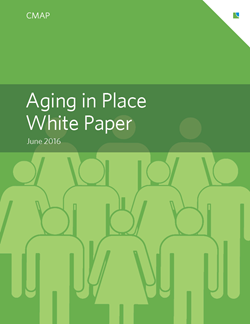WhitePaper
Aging in Place White Paper
Planning for the needs of seniors is a key priority and challenge for the region. The country's population of older residents has grown significantly over the past several decades and is projected to continue growing. According to the United States Census Bureau's 2014 National Projections, the number of residents who are 65 and older will increase by more than 50 percent by 2040, reaching approximately 82.3 million and representing 22 percent of the nation's population. Close to a fifth of these seniors (14.6 million people, or 18 percent of the total senior population) will be older seniors (85+).
In keeping with national trends, the senior population in metropolitan Chicago is also expected to continue increasing. CMAP's population projections predict that the region will be home to approximately 10.3 million residents by 2040. According to analysis conducted by Woods and Poole, seniors will represent 18 percent of the population and seniors over 75 will represent 10 percent of the population, up from 11 percent and 5 percent in 2010, respectively. This phenomenon will have major impacts on future housing, land use, and transportation demand. Communities will need to plan proactively to prepare for these changes, and to protect the rights and well being of vulnerable residents. Planning for an aging population is also an investment in the well being of all community members, as it benefits people of all ages and abilities, creating healthy, sustainable places that are livable for all residents.
This white paper focuses on best practices for supporting aging in place at the municipal level. The practices it highlights are intended to be incorporated into local planning processes and documents. Chapter Two of the white paper provides an overview of how to incorporate age-friendly practices into municipal planning processes. The subsequent chapters are organized by standard comprehensive plan chapters, and present specific strategies for aging in place. Each chapter outlines Priority Strategies and Additional Strategies. Priority Strategies are the strategies that are most important for a municipality to adopt, and are relevant to all types of communities. Additional Strategies provide supplementary best practices that are relevant to municipalities seeking to address aging in place more extensively. In some cases, Additional Strategies also include strategies that are not directly applicable to local government, but are appropriate for municipalities to address in collaboration with their county governments and state representatives, or with the private and non-profit sectors.
The white paper has been adapted by the Illinois Association of Realtors into a brochure and toolkit available on their Senior Housing Resources webpage. The adapted toolkit includes examples of age-friendly ordinances and programs from the region and across the United States.
